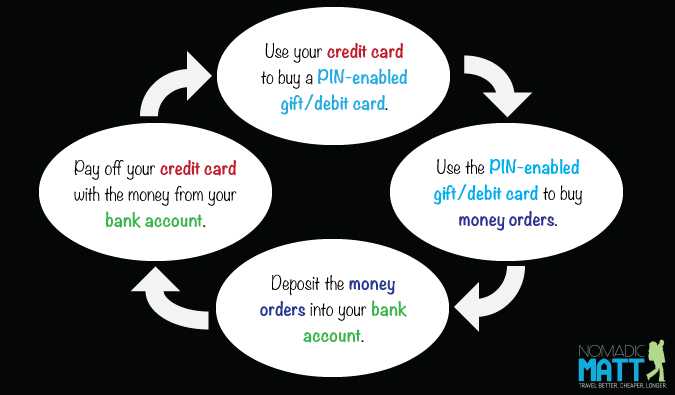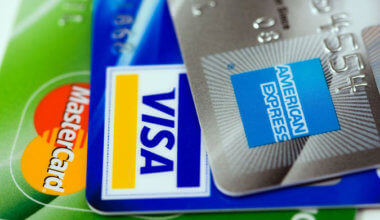
Last Updated: 7/28/2023 | July 28th, 2023
The best way to travel when you don’t have any money is to take money out of the equation. OK, not completely. While you can travel really, really cheaply, some money is required (unless you want to go hobo-style like this guy, in which case, this article isn’t for you).
But, assuming you don’t want to do that, you are going to need some money for travel. But you don’t need as much as you think you do, especially if you work to make your two biggest expenses — accommodation and flights — virtually free.
How?
By travel hacking.
I’ve written about it before, but I’ve never really broken down how I earn all those points and miles and redeem them for the business-class flights you always see me enjoying on Instagram. In this post, I’ll go into detail and provide the step-by-step breakdown of exactly what I do to earn around one million points a year — all without traveling! (And, when you add in the miles and points I get from traveling, it’s well over a million per year!)
This is going to be a long post, so get your coffee or tea ready.
First, a refresher: travel hacking is the art of collecting frequent flier, hotel, and credit card points and airline miles and redeeming them for free travel. But it’s not about spending lots of money — the idea is to “hack the system” and use rewards programs against themselves to get lots of points and miles without spending a lot of money or traveling a lot. You leverage these systems to your benefit.
And it’s not just for Americans — Canadians, UK residents, Australians, Kiwis, and Spaniards can work these systems in their favor. (In reality, anyone can, but it’s just easier if you’re in these countries. So, while I will use the American market as an example, as that is the one I have access to, the principles and strategies I use can apply to you. Just substitute your local cards and programs for mine!)
One quick note before we begin (especially to the travel hackers reading this): in the travel hacking world, my mileage earning is pretty small. I know people who earn multiple millions of miles a year but I value my time so why spend time earning miles I don’t need? I don’t waste time getting miles I don’t need.
Miles also lose value over time as airlines change their earning and burning rules so I would rather not waste time getting something with a decreasing value. Miles aren’t money.
Some people do this for the love of the game; I do this because I’m cheap and want to pay for as few flights and hotels as possible.
So here’s how I get those points and miles:
Table of Contents
- Step 1 – Get a Travel Credit Card
- Step 1a – Earn Points on Rent
- Step 2 – Meet the Minimum Spending Requirements
- Step 3 – Be Smart with Spending
- Step 4 – Rinse and Repeat on the Manufactured Spending
- Step 5 – Sign Up for Every Contest, Survey, and Deal in the World
- Step 6 – Buy Points/Miles….Sometimes
- Step 7 – Cancel Cards I Don’t Use
- Step 8 — Get a Second Round of Cards
Step 1 – Get a Travel Credit Card
Credit cards are the tool through which you run your money in order to accumulate your points and miles. Think of them as the points-and-miles printing press. You can earn points and miles without them, but the process takes a lot longer and is a lot harder. To make this work, you will need a credit card.
When used properly, credit cards are smart financial instruments. You can earn hundreds of thousands of miles per year that enable you to travel for free (and they offer better purchasing protection than your debit card). Simply having them won’t send you into debt or cost you high interest rates. Just make sure not to spend more than you have and to pay off your bill each month.
So, the first thing I do is apply for a bunch of these credit cards.
But I don’t do it willy-nilly.
As a crazy travel hacker, I have more cards than the average person needs, but I only apply for new cards to reach a specific goal. This is the important point to know before you begin: have a goal in mind. Think about the trip you want to take, where you want to stay, and how you want to get there, and then get the cards that help you get there.
What have I signed up for this year? In the last six months, I applied for the following cards:
- Chase Sapphire Preferred® Card – I re-applied for this card after a few years of not having it because the 80,000 point bonus was hard to pass up.
- Hilton Surpass and The Hilton Honors American Express Business Card – I’m trying to stay at more Hiltons so I picked up both these amazing cards for a total of 260,000 combined.
- United Explorer Card – 40,000 miles.
Total points earned: 380,000
One thing to note about credit cards is that you can’t just sign up, cancel, and sign up again. Many card companies make you wait 18–24 months before you become eligible for a sign-up bonus again. I cycle through cards on a multi-year basis.
Therefore, I try to space out my sign-ups. I do two or three big credit card sign-up frenzies per year. This allows me to meet any minimum spending requirements (see below), allows the temporary dip the application causes in my credit score to go away, and gets me around any red flags the credit card companies have.
(Note: Chase has something called the 5/24 rule, which states people who’ve applied for more than five cards from any issuer within a 24-month period can’t get a new card from them so you want to get your Chase cards first. American Express also only lets you earn the bonus once per card per lifetime.)
Moreover, despite popular belief, having a lot of credit cards won’t hurt you. In fact, it can help you. Outside of your payment history, your utilization is the next most important factor in your credit score.
Don’t worry about anything else. If you have $100,000 in available credit but only are using $5,000, that’s better than only having $5,000 in credit and using it all every month. Having more cards can actually help your credit score because of the better utilization ratio they create.
If you want to know the current best deals, here’s a list of my favorite credit card offers that offer the biggest rewards.
Step 1a – Earn Points on Rent
Additionally, I earn points on my rent. If you’re a renter in the United States, you have to get Bilt. Bilt is a no fee credit card that earns you points on paying rent. Even if your landlord doesn’t take credit cards, you can pay with Bilt. It acts like a virtual bank account. And they mail checks too. It’s a great card. In fact, the bonus points structure is so good, I use it for most of my everyday purchases too. Here’s a complete breakdown of how it works. If you pay rent and do not get this card, you’re being foolish! It’s a must!
Total points earned: 30,000
Step 2 – Meet the Minimum Spending Requirements
Each of these cards comes with a minimum spending requirement before you can earn that bonus. You just don’t get it for nothing.
Here’s how the cards broke down:
- Chase: $4,000 minimum spend
- Hilton business card: $3,000 minimum spend
- Hilton personal card: $2,000 minimum spend
- United: $2,000 minimum spend
That meant I had to spend over $11,000 in three months in order to meet the requirements and earn my bonuses!
But my everyday spending isn’t anywhere close to that.
Since the purpose of travel hacking is to not spend extra money (you should absolutely not go into debt for this), I had to figure out ways to meet those spending requirements without incurring extra debt. Here’s how I did it:
- In the US, you can pay your federal tax bill on a credit card for a fee of 1.87%. I don’t pay all my taxes during the year so that at the end of the year, I have to pay them in one large chunk. I then time that tax payment with a credit card sign-up so I can get the bonus. Yes, there is a fee, but if you work out the math, it’s worth it. That took care of a big chunk of this.
- I time my purchases and sign-ups. If I have to move, buy furniture, need a computer, or join a gym, I sign up for a card and then charge my big purchases to the card.
- I go out to dinner with my friends, pay, and ask them to reimburse me. This is especially easy with apps like Venmo nowadays, where they can reimburse you easily at the exact moment of payment.
- I ask friends and family if they have a big purchase they wouldn’t mind letting me put on my card. This doesn’t always work but often friends and family will let me put it on my card as a favor and then they’ll pay me instead of the store.
- I manufacture spending for the remainder. This is when you move money around so that you artificially create spending through gift cards and money orders. You can buy pre-paid debit cards, turn them into money orders, put those money orders in your bank account, and then pay off your credit card. You have to pay a fee for the cards and money orders, but when doing this for sign-up bonuses, it’s worth the cost. I purchase pre-paid debit cards in $500 increments.
Note: As I incur a lot of business expenses, it’s easy for me to meet the minimum spending requirements for business cards. The steps outlined above were used for the personal cards.
Total spend points earned: 25,000 (21,000 in spending, plus category bonuses (see below on food and office supplies; my tax bill represented half my spending)
Step 3 – Be Smart with Spending
1. Use category bonuses
In the movie Up in the Air, George Clooney’s character never wastes an opportunity to earn points. I’m the same way. I never, ever, ever just earn one point per dollar spent if I can get 2, 3, or 6 points per dollar spent.
Certain cards have what are known as category bonuses, where you receive 2–5 points per dollar spent. It varies by card, but generally, you get 2 points on restaurants, 2–3 on airfare, and 5 on office supplies.
For example, if I am buying an airline ticket, I’ll use my American Express Platinum and get 5 miles for every dollar I spend. When I’m eating out, I’ll use my Chase Sapphire Reserve for 3 points on dining. If I’m booking a Delta flight, I’ll use that card for 5 points per dollar spent.
In short, I’m always trying to get more than one point for every dollar I spend.
2. Use airline shopping portals
All airlines, hotels, and travel brands have preferred merchants. These companies — ranging from clothing retailers to sporting good stores to office supply businesses and everything in between — partner with airlines’ (hotels’, etc.) special shopping malls. By ordering online through these malls, you can earn additional points.
You can use Evreward or Cash Back Monitor to discover the current best deals across various programs. Simply type in the merchant or product you want, and it will compile a list of bonuses the various point programs are offering at that moment so can you maximize the programs to purchase from.
Say, for example, you want new clothes from the Gap. Going into the Gap store gets you one point per dollar spent. By using Evreward, you see that by going the United shopping portal, signing in, clicking the link to Gap, and purchasing online you can earn three points per dollar spent. Suddenly, you get 300 points instead of 100 for your $100 shopping spree!
That’s basically what you do for everything. Always look to see where you can get extra points.
3. Use Dining Rewards Programs
Just like shopping portals, airlines also have dining rewards programs. You sign up with your frequent flier number, register your credit card, and get extra points when you dine at participating restaurants in the airline’s network (which rotate throughout the year). It’s important to note that while you can sign up for every program, you cannot register a credit card with more than one. That means that if your Chase Sapphire Preferred card is tied to your American Airlines account, you can’t earn miles on your United Airlines account with that same card.
Join one of the programs in the Rewards Network (they run all the dining programs) so you can get five miles per dollar spent once you became a “VIP member,” which happens after 12 dines. So if you get those 12 under your belt (so to speak) early in the year, for the rest of the year you’ll be racking up five points per dollar spent!
A note on keeping track of all this: As I was writing this post, I went to dinner with a few friends. My buddy Noah was like “This is too much to keep track of.” That’s a common feeling among people looking to start travel hacking. However, it appears more complicated than it really is. Once you know what cards give you what bonuses, the next step is to simply use the cards that get those bonuses and meet your goals.
You never want to spread yourself too thin though. having points all over the place will lead you to having low point balances in multiple accounts. I tend to stick to just a few accounts with my everyday spending on Chase Ultimate Rewards and American Express Membership Rewards since they are transferrable points. (Note: Since I solely fly Delta, I don’t worry about building miles in that account as I get plenty through flying and non-bonus business spending on the card.)
Total points earned per year: roughly 100,000 (spending and bonus category dependent)
Step 4 – Rinse and Repeat on the Manufactured Spending
Can’t meet minimum spending requirements or want to generate oodles of miles on a very low budget? No problem. You can “manufacture” spending to meet the credit card spending requirements and earn additional miles through the use of closed-loop, money-moving techniques using prepaid gift cards and other financial instruments.
Using Amex Offers or discounted card websites (see the list below), you purchase a stack of gift cards. Never buy cards at full price. Never ever ever!
Where to buy gift cards and find deals:
Next, you sell your cards for money. (If they are physical cards, you have to mail them in.) The websites above are good websites for this too.
Then, use the money to pay off your credit card.
Let’s say there is a deal on Starbucks gift cards for 15% off. Using your credit card, you buy Starbucks gift cards in bulk and then resell them to one of the above merchants, who buys the card at 14% off. You take the money and pay off your credit card. In the process, you eke out a small profit and gain a bunch of points.
How do you find these deals? Doctor of Credit can alert you when there is a deal. People who do this a lot have their own way of tracking but, for the casual travel hacker, these websites take the work out of it.
While this may seem easy, it’s not. Many people have flooded this market and so the profit margins are really thin. Unless you’re doing this in bulk, it’s not going to be super profitable and you might even lose money or barely break even. You don’t do this for a hundred dollars—you do this for tens of thousands of dollars. You also have to be OK with waiting to get paid back as you can wait weeks before you get paid back—meaning you may have to front the money to pay your credit card first.
You also need to be able to keep track of thousands of cards, where they are going, which cards were used, when payments are due, percentages, and everything in between. Spreadsheets are needed here. If you’re going to be a gift card reseller, do this with extreme caution. This is not something to do willy nilly.
I don’t do this every month (you can’t do it while traveling) but this helps me offset minimum spending requirements on cards and earn a few extra miles each year.
Total points earned per year: 50,000-100,000
(Note: I use my Chase Ink business card a lot at Staples. I buy Amazon, iTunes, and restaurant gift cards to be sure I maximize the 5 points per dollar spent bonus.)
Step 5 – Sign Up for Every Contest, Survey, and Deal in the World
Airlines and hotels often offer points and bonuses for signing up for a deal, taking a survey, filling out a form on Facebook, etc. The points here are small (100-1,000 at a time) but, over the course of a year, they can add up.
Moreover, the two companies below will give you cash gift cards for filling out consumer surveys:
Total points earned per year: 10,000-20,000
Step 6 – Buy Points/Miles….Sometimes
Airlines and hotels sometimes offer really good deals for points/miles and, if I know I am going to use them soon, I’ll buy them at a discount. This basically lets you buy flights for cheaper than booking them.
For example, Lifemiles (Avianca’s membership program) often does a promotion where you can get a 135% bonus on bought miles. If you max the promotion out, you usually get 352,000 miles for around $4,900, but at that rate, you’re buying miles for 1.4 cents per mile, which is an amazing deal. (The closer you get to 1 cent per mile, the better the deal! Follow websites like View from the Wing or One Mile at a Time and they alert you to all these point offers, break it down, and basically tell you if this is a good deal or not.)
It may sound crazy to spend that much money on miles (and you certainly don’t need to do it at all), but let’s put it in perspective. For 90,000 miles, you can book a one-way first-class flight from the US to Asia. Since you spent 1.4 cents per mile, that ticket works out to be $1,260. Not too bad for a first-class ticket, huh?
Buying points and miles is a way to pad your balance and buy tickets at a steep discount. I do this sometimes if I’m traveling soon and know I’m going to paying for the ticket anyway (I don’t always use miles when I travel). It’s not free, but I would rather buy a first-class ticket for $1,260 than an economy ticket for the same price.
Sometimes travel hacking is about finding value and doing a bit of arbitrage to get more for less!
Points earned: 100,000 points
Step 7 – Cancel Cards I Don’t Use
Airline cards have fees so, when the yearly fee comes due, I’ll cancel the cards I don’t use or that don’t have a benefit to me. For example, the British Airways card: I used it for the sign-up miles and was done with it. It was canceled.
The Hyatt card? It has a $75 yearly fee but comes with two nights free each year. That’s two nights in a hotel for $75. I keep that one.
Canceling cards doesn’t hurt your credit score. Old credit lines help, which is why I keep my oldest cards around. They have no fees and high limits so they anchor my credit score.
As I said before, what is important is your overall debt-to-credit ratio. So canceling a few cards lowers that ratio, but if I have no debt it doesn’t matter.
Moreover, I also transfer the credit lines to other cards with that card company so that I don’t lose the credit so be sure to ask your credit card company if you can do the same.
Step 8 — Get a Second Round of Cards
As I said in the beginning, I get cards twice a year. So, when it is time to get cards again, I get a bunch of new cards then repeat step 2 to meet any minimum spending requirements.
Total points earned: 200,000-300,000
Total points earned: roughly 960,000-1,060,000 per year
(The above tricks don’t count all the miles I earn via business expenses, which add up to an additional couple hundred thousand miles a year, putting me well over one million miles earned.)
A lot of travel hacking depends on how much time and effort you put into this. If I got more credit cards, I could earn more points. If I devoted more time to this, I could work the system more and get even more miles. I just don’t care enough. I have more miles than I need.
By using the eight steps outlined in this article, the sky is the limit on how many miles you can earn. It just depends on how much you want to ramp up each step. As I said before, my million miles per year is a small number compared to some of the other travel hackers out there.
However, no matter your effort level, you should do this. Even if you travel only once a year. Travel hacking isn’t complicated. It’s simple and accessible to everyone.
After all, free travel is the best travel.
Book Your Trip: Logistical Tips and Tricks
Book Your Flight
Find a cheap flight by using Skyscanner. It’s my favorite search engine because it searches websites and airlines around the globe so you always know no stone is being left unturned.
Book Your Accommodation
You can book your hostel with Hostelworld. If you want to stay somewhere other than a hostel, use Booking.com as it consistently returns the cheapest rates for guesthouses and hotels.
Don’t Forget Travel Insurance
Travel insurance will protect you against illness, injury, theft, and cancellations. It’s comprehensive protection in case anything goes wrong. I never go on a trip without it as I’ve had to use it many times in the past. My favorite companies that offer the best service and value are:
- SafetyWing (best for everyone)
- Insure My Trip (for those 70 and over)
- Medjet (for additional evacuation coverage)
Want to Travel for Free?
Travel credit cards allow you to earn points that can be redeemed for free flights and accommodation — all without any extra spending. Check out my guide to picking the right card and my current favorites to get started and see the latest best deals.
Need Help Finding Activities for Your Trip?
Get Your Guide is a huge online marketplace where you can find cool walking tours, fun excursions, skip-the-line tickets, private guides, and more.
Ready to Book Your Trip?
Check out my resource page for the best companies to use when you travel. I list all the ones I use when I travel. They are the best in class and you can’t go wrong using them on your trip.



